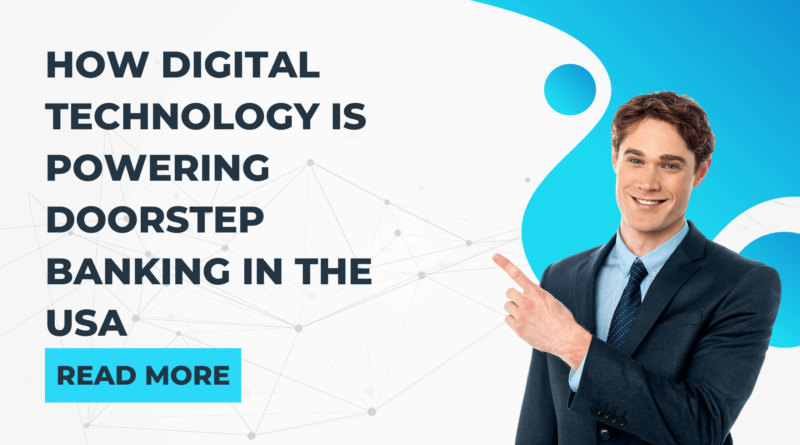How Digital Technology is Powering Doorstep Banking in the USA
In an era where convenience and accessibility are paramount, the banking industry in the USA is undergoing a significant transformation. Digital technology is no longer just an add-on to traditional banking services; it is becoming the core engine driving innovation and redefining how banking is delivered to consumers. Doorstep banking, once a concept limited to specific niche markets, is now rapidly becoming mainstream, powered by advancements in mobile technology, artificial intelligence, and secure digital platforms.
The shift towards digital transformation in banking is not just about providing customers with more options; it’s about creating a seamless, personalized, and secure banking experience right at their doorsteps. This trend is particularly crucial in today’s landscape, where the demand for contactless services has surged, driven by the necessity to minimize physical interactions. The fusion of technology and doorstep banking is setting a new standard for customer service, and the USA is at the forefront of this digital revolution.
Current Landscape of Doorstep Banking in the USA
The current landscape of doorstep banking in the USA reflects a dynamic shift from conventional banking models to more innovative, customer-centric approaches. Major financial institutions, along with agile fintech startups, are leading the charge by leveraging digital technology to bring banking services directly to customers’ homes. This evolution is not just a response to the growing consumer demand for convenience but also a strategic move to enhance financial inclusion across diverse demographics.
Digital technology has enabled banks to offer a variety of services through doorstep banking. For instance, mobile banking apps now allow customers to perform complex financial transactions without ever stepping foot in a bank branch. Meanwhile, the integration of AI-powered chatbots and personalized financial advice services ensures that even the most tech-averse customers can access banking services with ease. The use of biometric verification and secure digital identities further enhances the security of these transactions, building trust among users.
Moreover, fintech companies are playing a pivotal role in expanding the reach of doorstep banking. By offering tailored solutions that cater to specific needs, such as small business loans or personal finance management, these companies are making banking more accessible to underserved populations. This digital-first approach not only improves customer satisfaction but also drives operational efficiency, allowing banks to serve more customers with fewer resources.
As we move forward, the landscape of doorstep banking in the USA will continue to evolve, driven by ongoing advancements in technology and an increasing emphasis on customer experience. The future of banking lies in the seamless integration of digital tools that make financial services as easy and intuitive as possible, right from the comfort of one’s home.
Key Digital Technologies Enabling Doorstep Banking
The rapid advancement of digital technologies has fundamentally reshaped how financial services are delivered, bringing the bank to the customer’s doorstep. Here are the key digital technologies driving this transformation:
Mobile Banking Applications
Mobile banking apps have become the cornerstone of doorstep banking, enabling customers to access a wide array of financial services from their smartphones. These applications provide a user-friendly interface that allows customers to perform transactions, check balances, apply for loans, and even receive personalized financial advice—all without leaving their homes. The integration of push notifications and real-time alerts further enhances the customer experience by keeping users informed about their account activities.
Artificial Intelligence (AI) and Machine Learning (ML)
AI and ML are revolutionizing doorstep banking by providing personalized and predictive services that cater to individual customer needs. AI-driven chatbots, for instance, offer instant customer support and can guide users through complex transactions. Meanwhile, machine learning algorithms analyze customer data to predict financial behaviors, allowing banks to offer tailored products and services. These technologies not only improve customer satisfaction but also optimize the bank’s operational efficiency by automating routine tasks.
Biometric Verification
Security is a critical concern in doorstep banking, and biometric verification has emerged as a powerful tool to address this challenge. Technologies such as fingerprint scanning, facial recognition, and iris detection ensure that transactions are secure and that customer identities are verified without the need for physical documents. This not only enhances the safety of banking transactions but also speeds up the process, making doorstep banking more convenient and reliable.
Remote Identification and eKYC
Know Your Customer (KYC) processes are essential for verifying customer identities and ensuring compliance with regulatory requirements. Remote identification and electronic KYC (eKYC) have streamlined this process, allowing customers to verify their identities online using digital documentation. This technology enables banks to onboard new customers quickly and securely, expanding the reach of doorstep banking services to even the most remote areas.
Blockchain Technology
Blockchain technology is increasingly being recognized for its potential to enhance the transparency and security of financial transactions. In doorstep banking, blockchain can be used to create secure and immutable transaction records, reducing the risk of fraud and ensuring that all parties have a clear, tamper-proof record of their transactions. Additionally, smart contracts enabled by blockchain can automate and enforce the terms of agreements between banks and customers, further enhancing the efficiency and reliability of doorstep banking services.
Case Studies of Doorstep Banking Initiatives in the USA
The United States has seen a variety of innovative doorstep banking initiatives, driven by both traditional banks and fintech companies. Here are some notable examples:
JPMorgan Chase’s Mobile Banking Units: JPMorgan Chase has been a pioneer in bringing banking services directly to customers’ homes. The bank launched mobile banking units that travel to underserved communities, offering essential services such as account opening, cash deposits, and financial advice. These units are equipped with advanced digital tools, allowing customers to perform transactions on the spot, guided by bank representatives who use tablets and mobile devices to access banking systems.
Bank of America’s AI-Powered Customer Service: Bank of America has integrated AI-powered virtual assistants into its mobile banking app, enabling customers to perform a range of banking activities from their homes. The virtual assistant, known as Erica, helps customers manage their finances, pay bills, and even receive personalized financial advice. This initiative has significantly enhanced the bank’s ability to provide convenient and efficient services, particularly to those who prefer not to visit a physical branch.
Chime’s Digital-Only Banking Model: Chime, a leading fintech company, has embraced a digital-only model, offering its banking services exclusively through its mobile app. Chime’s approach eliminates the need for physical branches, providing customers with a fully digital banking experience. The company’s app offers a wide range of services, including early direct deposit, fee-free overdrafts, and real-time transaction notifications, making it a popular choice for tech-savvy consumers seeking convenience and flexibility.
Square’s Financial Services for Small Businesses: Square, initially known for its payment processing solutions, has expanded into the banking sector by offering tailored financial services to small businesses. Through its app, Square provides business loans, payment processing, and financial management tools directly to business owners. This digital-first approach allows Square to serve businesses that might otherwise have limited access to traditional banking services, particularly in rural or underserved areas.
Citibank’s Blockchain Initiatives: Citibank has been exploring the use of blockchain technology to enhance its banking services, particularly in the realm of international transactions. By leveraging blockchain, Citibank aims to provide faster, more secure cross-border payments, reducing the time and cost associated with traditional methods. This initiative is part of Citibank’s broader strategy to incorporate cutting-edge digital technologies into its service offerings, ensuring that it remains competitive in the rapidly evolving banking landscape.
Benefits of Doorstep Banking Powered by Digital Technology
The integration of digital technology into doorstep banking offers a multitude of benefits, transforming the way customers interact with financial institutions. Here’s how digital technology is enhancing doorstep banking:
Convenience and Accessibility
One of the most significant benefits of digital technology in doorstep banking is the unparalleled convenience it offers. Customers can access a wide range of banking services without leaving their homes, eliminating the need for time-consuming trips to physical bank branches. Whether it’s checking account balances, transferring funds, or applying for loans, these tasks can be accomplished with just a few taps on a mobile device. This accessibility is particularly beneficial for elderly individuals, people with disabilities, or those living in remote areas, who may find it challenging to visit a bank in person.
Enhanced Financial Inclusion
Digital technology is playing a crucial role in extending banking services to underserved populations. Through mobile apps, remote identification, and eKYC processes, banks can now reach individuals who previously lacked access to formal banking services. This expansion of services is helping to bridge the gap between the banked and unbanked populations, promoting greater financial inclusion across the USA. As a result, more people are gaining access to essential financial services, such as savings accounts, credit, and insurance, which can significantly improve their economic well-being.
Increased Efficiency and Cost Savings
For banks, the adoption of digital technology in doorstep banking leads to increased operational efficiency and cost savings. By automating routine processes like customer verification, transaction processing, and customer service through AI and machine learning, banks can reduce the need for manual intervention, leading to faster and more accurate service delivery. This efficiency not only improves the customer experience but also allows banks to serve a larger customer base without a proportional increase in costs. Additionally, the reduced reliance on physical branches means that banks can cut down on overhead expenses related to maintaining brick-and-mortar locations.
Improved Security
Security is a top priority in the financial industry, and digital technology provides robust solutions to protect customer data and transactions. Biometric verification methods, such as fingerprint and facial recognition, ensure that only authorized users can access their accounts, significantly reducing the risk of fraud. Blockchain technology further enhances security by providing a tamper-proof ledger for recording transactions, ensuring that all activities are transparent and traceable. These advancements in security give customers greater confidence in using doorstep banking services, knowing that their financial information is well-protected.
Challenges and Risks of Implementing
While digital technology offers numerous advantages for doorstep banking, it also presents certain challenges and risks that need to be addressed:
Cybersecurity Threats
As banks increasingly rely on digital platforms, they become more vulnerable to cyberattacks. Hackers are constantly developing new methods to breach security systems, potentially compromising sensitive customer data. Phishing attacks, malware, and ransomware are just a few of the threats that banks must guard against. To mitigate these risks, banks need to invest in advanced cybersecurity measures, such as encryption, multi-factor authentication, and continuous monitoring of digital systems. However, staying ahead of cybercriminals in this ever-evolving landscape remains a significant challenge.
Digital Divide and Accessibility Issues
Despite the widespread adoption of digital technology, there remains a digital divide that can limit the effectiveness of doorstep banking. Not all customers have access to high-speed internet or the necessary devices to use digital banking services. Additionally, some individuals, particularly older adults or those with low digital literacy, may struggle to navigate mobile apps and online platforms. This divide can lead to a situation where certain segments of the population are left behind, unable to fully benefit from the convenience of doorstep banking. Banks must therefore consider strategies to make their services more accessible, such as offering user-friendly interfaces and providing support for those who are less tech-savvy.
Regulatory and Compliance Challenges
The banking industry is heavily regulated, and the shift to digital platforms introduces new compliance challenges. Banks must ensure that their digital services adhere to a complex web of regulations, including those related to data protection, anti-money laundering (AML), and customer privacy. Navigating these regulations can be difficult, especially as they vary across different states and jurisdictions. Failure to comply can result in hefty fines and damage to the bank’s reputation. Therefore, banks must work closely with regulatory bodies to ensure that their digital initiatives are fully compliant with all relevant laws and regulations.
Reliability and Technical Issues
The reliance on digital technology means that banks must ensure the reliability of their systems at all times. Technical issues such as server outages, software bugs, or connectivity problems can disrupt service delivery, leading to customer dissatisfaction and potential financial losses. For instance, if a mobile banking app crashes during a transaction, it could result in delays or errors that affect the customer’s trust in the bank. To minimize these risks, banks need to invest in robust IT infrastructure, regular system updates, and disaster recovery plans to ensure that their digital platforms remain reliable and operational.
The Future of Doorstep Banking in the USA
The landscape of doorstep banking in the USA is poised for significant evolution, driven by the continuous advancements in digital technology. As we look to the future, several trends and innovations are likely to shape how banking services are delivered to customers at their doorsteps.
Integration of Artificial Intelligence and Predictive Analytics
The future of doorstep banking will be heavily influenced by AI and predictive analytics. Banks will leverage these technologies to offer more personalized services, anticipating customer needs before they even arise. For instance, AI could analyze a customer’s financial behavior to predict when they might need a loan or when they’re likely to make a large purchase, and then proactively offer tailored financial solutions. This level of personalization will not only enhance customer satisfaction but also deepen the relationship between banks and their clients.
Expansion of Blockchain and Decentralized Finance (DeFi)
Blockchain technology is expected to play a more prominent role in the future of doorstep banking, particularly in the realm of decentralized finance (DeFi). As blockchain becomes more integrated into banking systems, customers will benefit from faster, more secure transactions that are less reliant on traditional banking intermediaries. This could also lead to the development of new financial products and services that operate entirely on decentralized platforms, offering greater flexibility and accessibility to customers.
Growth of 5G Networks and IoT Integration
The rollout of 5G networks across the USA will significantly enhance the capabilities of mobile banking and doorstep services. With faster internet speeds and lower latency, customers will experience seamless interactions with banking apps, even in remote areas. Additionally, the integration of the Internet of Things (IoT) will allow for smarter, more connected banking experiences. For example, IoT devices could automate various aspects of personal finance management, such as budgeting and bill payments, making doorstep banking even more convenient.
Increased Focus on Financial Inclusion
As digital technology continues to evolve, there will be a stronger emphasis on financial inclusion. Banks and fintech companies will develop more targeted initiatives to bring banking services to underserved communities, particularly in rural areas. The use of digital identity verification, mobile banking, and micro-financing platforms will be key to achieving this goal. By ensuring that everyone has access to banking services, the future of doorstep banking will contribute to reducing the financial disparity across the country.
Sustainability and Green Banking Initiatives
The future of banking will also see a growing emphasis on sustainability, with banks adopting green banking practices as part of their doorstep services. This could include offering loans and financial products that incentivize environmentally friendly practices, as well as using digital technology to reduce the carbon footprint of banking operations. As consumers become more environmentally conscious, banks that align their services with sustainability goals will likely gain a competitive edge.
Also Read:
AI Startup Ideas and Their Key Features Industry Wise
How AI in Education is Transforming the Industry
Conclusion
In conclusion, digital technology is undeniably transforming the way banking services are delivered in the USA, with doorstep banking emerging as a key trend. From the integration of mobile banking apps to the use of AI, blockchain, and biometric verification, these advancements are making banking more accessible, convenient, and secure for customers across the country.
However, as banks and fintech companies embrace these innovations, they must also navigate the associated challenges and risks, including cybersecurity threats, regulatory compliance, and the digital divide. By addressing these issues proactively, the banking industry can ensure that the benefits of digital technology are fully realized, paving the way for a more inclusive and efficient financial ecosystem.
Looking ahead, the future of doorstep banking in the USA is bright, with continued advancements in technology promising to further enhance the customer experience. As AI, blockchain, 5G, and IoT technologies evolve, we can expect even greater personalization, security, and accessibility in doorstep banking services. Moreover, the focus on financial inclusion and sustainability will ensure that the benefits of these innovations are widely distributed, contributing to a more equitable financial landscape.
In this rapidly changing environment, banks that embrace digital transformation and prioritize customer-centric approaches will be well-positioned to thrive. The future of banking is at the doorstep, and with the right strategies in place, it will open new doors of opportunity for both financial institutions and their customers.




